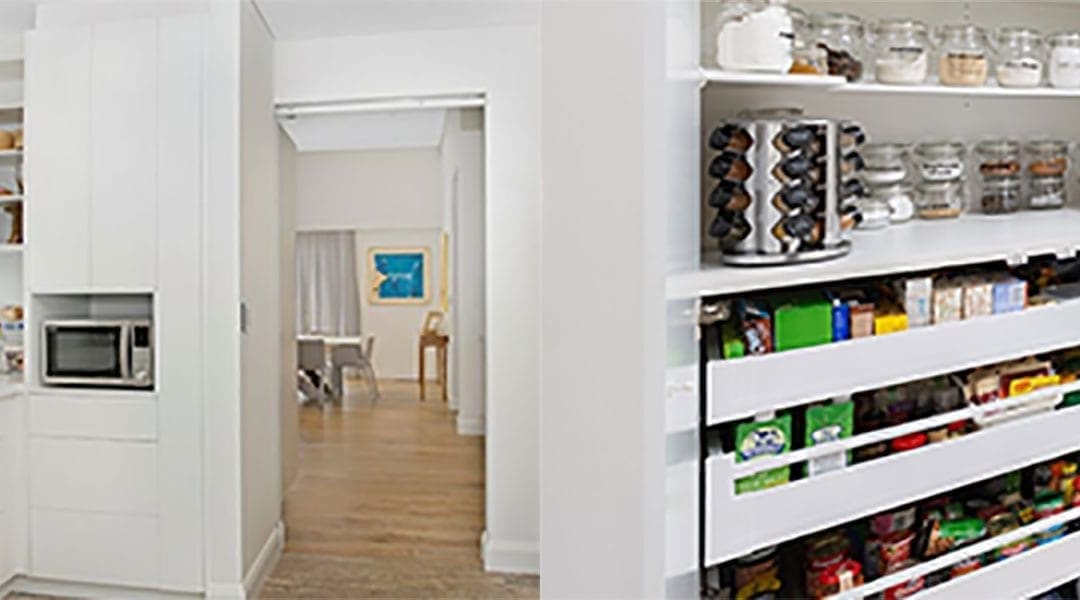Contemplating whether a walk in or cabinet kitchen pantry is best for your home? Like many kitchen design items, there is a time and a place for each. So, to help with the conundrum, check out these simple pros and cons of kitchen pantries that we have put together.
To many people, a walk-in kitchen pantry is the dreamboat of storage. Decked ceiling to floor with shelving and storage solutions, some people fear anything less could jeopardise their ability to fill every nook and cranny with more goods than a corner store. But, it’s sometimes more beneficial to dedicate kitchen pantry space to other uses and integrate a professionally designed, more intimate cabinet kitchen pantry instead.
Before the kitchen pantry became popular, people typically stored pantry wares within their general kitchen cabinets. Nowadays, you can have everything from a gigantic Butler’s pantry to smaller walk-in pantries and kitchen pantries that slide out of a space no wider than the length of a 30cm ruler! Whichever style you choose, one thing is for sure – kitchen pantries make kitchen storage more structured, streamlined and organised.
So, how do you know which kitchen pantry option is best for you? It seems the more we are spoiled for choice, the harder it becomes to make a decision. To help break it down, our Harrington Kitchens design team have put together the following list of pros and cons of kitchen pantries.
Walk-in kitchen pantry
Like we mentioned earlier, the walk-in kitchen pantry seems to be the first choice when people think ‘kitchen pantry’. And, we get why it is usually so popular. However, there are plenty of cons of a walk-in kitchen pantry to consider as well.
Walk-in kitchen pantry pros
- Acts as a standalone area for non-perishable food storage
- Generally offers a surplus of storage space that is large enough to house cooking utensils, pots and pans, large platters, small appliances and items such as cookbooks
- In most cases, storage inside a walk-in kitchen pantry can be fitted from floor to ceiling if needed
- A walk-in kitchen pantry can incorporate a door or open entry (no door)
- Allows plenty of flexibility with regards to portable storage options such as baskets and containers, as well as custom-built storage
Walk-in kitchen pantry cons
- Location tops the list of cons regarding walk-in kitchen pantry They are usually either located within the main kitchen area and take up a fair chunk of space. Or, they are located outside of the main cooking quarters making it inconvenient to grab items quickly (which can be troublesome whilst cooking and some might say quite annoying)
- Walk-in kitchen pantries are typically generous, taking up plenty of kitchen real estate. If you don’t have the luxury of unlimited space to work with (which most of us don’t!) ask yourself is cooking and preparation space more important to you or would you prefer to have a generous-sized walk-in kitchen pantry?
- Larger also means more maintenance to keep it clean (it’s like another room in the house so walk-ins will often require regular dusting and wiping down)
- A walk-in kitchen pantry usually requires a longer time to gather up ingredients than it would from a cabinet pantry
- As the main inclusion in walk-in kitchen pantries are typically shelves, walk-ins also tend to collect more clutter and are easier to fall out of organisation
- Shelves are great for storage however, they are tough to fill all the way to the back and often the space at the back is wasted (especially the in the corner)
- Further to the above point, stacking items behind each other means items become obscured and often leads to increased food wastage
Cabinet kitchen pantry
Compared to a walk-in kitchen pantry, a cabinet pantry is a more intimate arrangement targeted for food storage. Although often considered smaller than walk-in’s, cabinet pantries can vary in size and are highly dependent on individual needs. Functionality is the optimal design aspect of a cabinet kitchen pantry.
Cabinet pantry pros
- Cabinet kitchen pantries generally confine everything into a more intimate space which can mean less time and energy spent gathering items and more time being productive
- Cabinet pantries provide the perfect opportunity to add customised storage solutions such as pull-out slider units, drawers, flip-up sections and shelving. This can make it easier to store and locate items.
- Due to the customised storage options available, cabinet pantries are generally easier to keep clutter-free and maintain
- Cabinet kitchen pantries are designed into cabinetry (hence the name) and as a result do not require the amount of additional space needed for a walk-in
- Generally cabinet kitchen pantries are located within the kitchen with a primary focus on accessibility
Cabinet pantry cons
- Restrict storage options for additional tems such as pots and pans, appliances, etc. If extra storage is an important aspect of your kitchen pantry, you might consider using more than one cabinet pantry.
- Depending on the complexity of design and inclusions (like sliders, drawers, etc), a customised cabinet kitchen pantry can be costlier than a simple walk-in pantry
- Cabinet pantries generally eat into bench space. Depending on the size, you might need to counterbalance this with an additional prep area such as a Butcher’s block
Never underestimate the benefit of a great kitchen panty design; huge is not necessarily best!
If you are still reluctant to give up on the idea of a walk-in kitchen pantry for the simple fear of missing out, then we suggest you get friendly with a paper and pen. Write down what it is that you really want (and need) from your kitchen pantry before setting your mind in stone.
Need help working out which kitchen pantry design will meet your needs the best? Our highly-experienced team of kitchen designers can recommend and custom design kitchen storage solutions for any kitchen, big or small. Call us on 1300 662 112, submit an online enquiry or visit us at our Narellan or Bowral showrooms.


Recent Comments